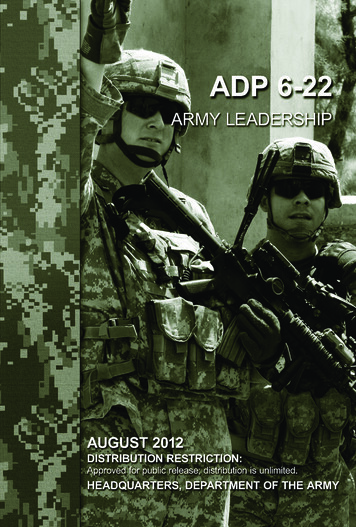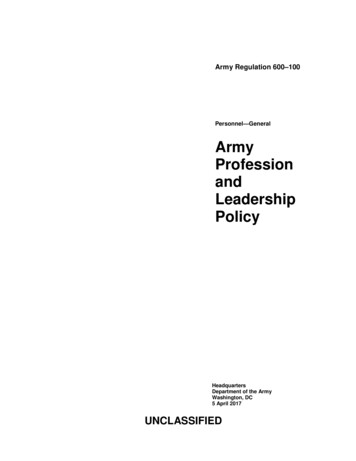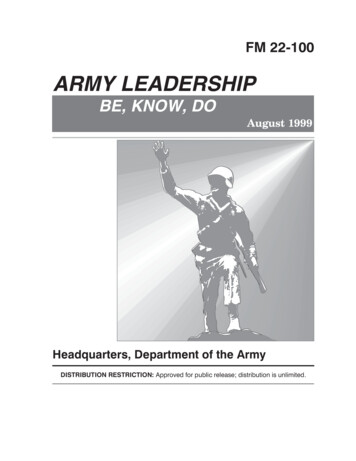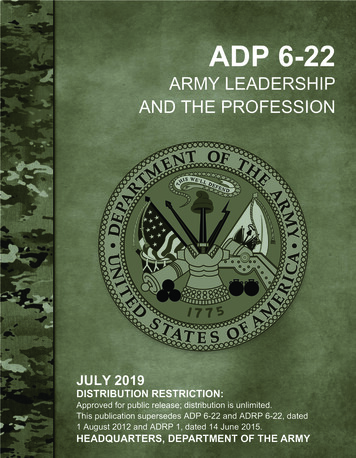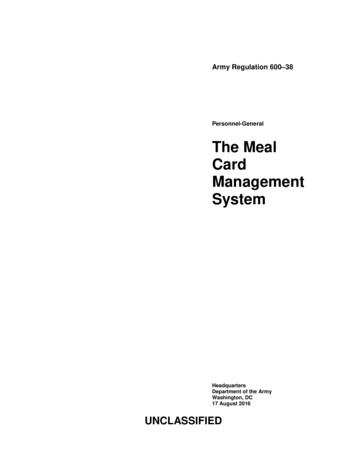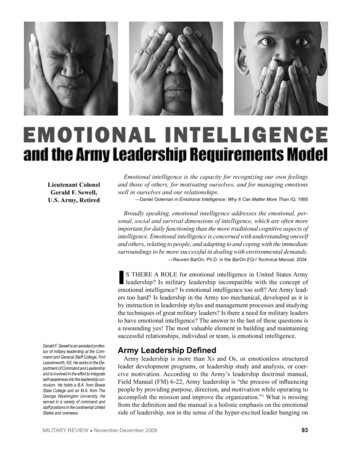
Transcription
Lieutenant ColonelGerald F. Sewell,U.S. Army, RetiredEmotional intelligence is the capacity for recognizing our own feelingsand those of others, for motivating ourselves, and for managing emotionswell in ourselves and our relationships.—Daniel Goleman in Emotional Intelligence: Why It Can Matter More Than IQ, 1995Broadly speaking, emotional intelligence addresses the emotional, personal, social and survival dimensions of intelligence, which are often moreimportant for daily functioning than the more traditional cognitive aspects ofintelligence. Emotional intelligence is concerned with understanding oneselfand others, relating to people, and adapting to and coping with the immediatesurroundings to be more successful in dealing with environmental demands.—Reuven BarOn, Ph.D. in the BarOn EQ-I Technical Manual, 2004.IS THERE A ROLE for emotional intelligence in United States Armyleadership? Is military leadership incompatible with the concept ofemotional intelligence? Is emotional intelligence too soft? Are Army leaders too hard? Is leadership in the Army too mechanical, developed as it isby instruction in leadership styles and management processes and studyingthe techniques of great military leaders? Is there a need for military leadersto have emotional intelligence? The answer to the last of these questions isa resounding yes! The most valuable element in building and maintainingsuccessful relationships, individual or team, is emotional intelligence.Gerald F. Sewell is an assistant professor of military leadership at the Command and General Staff College, FortLeavenworth, KS. He works in the Department of Command and Leadershipand is involved in the effort to integrateself-awareness into the leadership curriculum. He holds a B.A. from BowieState College and an M.A. from TheGeorge Washington University. Heserved in a variety of command andstaff positions in the continental UnitedStates and overseas.Army Leadership DefinedArmy leadership is more than Xs and Os, or emotionless structuredleader development programs, or leadership study and analysis, or coercive motivation. According to the Army’s leadership doctrinal manual,Field Manual (FM) 6-22, Army leadership is “the process of influencingpeople by providing purpose, direction, and motivation while operating toaccomplish the mission and improve the organization.”1 What is missingfrom the definition and the manual is a holistic emphasis on the emotionalside of leadership, not in the sense of the hyper-excited leader banging onMILITARY REVIEW November-December 200993
the desk or screaming at new recruits, or the muchtabooed “touchy-feely” leader, but leaders awareof their own emotions and how they affect thosearound them as they undertake the daily missionsand tasks assigned them. According to psychologist and author Daniel Goleman, to be successful, aleader must exercise and be aware of his emotionsand how his emotional competence influences theway he leads and impacts his followers.2FM 6-22 outlines the attributes and competencies required of Army leaders. But who makes upthe Army’s corps of leaders? FM 6-22 tells us anArmy leader is anyone who, by virtue of assumedrole or assigned responsibility, inspires and influences people to accomplish organizational goals.Army leaders motivate people both inside andoutside the chain of command to pursue actions,focus thinking, and shape decisions for the greatergood of the organization.3 The general public’sidea of an Army leader is the crusty old NCO orthe charismatic officer leading troops into battle orthe well-decorated general giving the inspirationalspeech. However, based on the Army’s definition,its leaders are persons that satisfy the responsibilities within that definition; that is, Soldiers, civilians,noncommissioned officers, warrant officers, andcommissioned officers; indeed, the full gamut ofpersonnel in the Army system. The Army recognizes that every person has the ability and potentialto be a leader. All of the Army’s leaders can benefitfrom a greater understanding of their emotions andthe emotions of others.Emotional Intelligence:A Brief HistoryEmotional intelligence is hardly a new field ofstudy; it is based on a long history of research andtheory in the fields of psychology, human intelligence, and the social sciences. In his 1983 bookFrames of Mind, Harvard psychologist HowardGardner indicates that the study of the emotionalside of intelligence can be traced back to the early1800s to the studies of Franz Joseph Gall and hisassociate, Johann Gaspar Spurzheim, who identified the presence of three affective faculties inthe brain—reverence, self-esteem, and reflectivepowers.4 Dr. Reuven BarOn, author and developerof the Emotional Quotient Inventory, identifiesDavid Wechsler and his studies on “the nonintellective94aspects of general intelligence” conducted in 1940as the foundation for the study of emotional intelligence.5 Some of the most notable groundbreakingwork in the field was done by Gardner. In Framesof Mind, Gardner proposed that there was not justone type of intelligence quotient (IQ) that led tosuccess in life, but a wide spectrum of intelligencesand at least four varieties of interpersonal intelligence.6 Gardner writes of two types of personalintelligence that both deal with the emotions. Hespeaks of intrapersonal intelligence, which is theinternal aspects of a person, and the interpersonalintelligence, which turns outward towards otherindividuals. 7 Gardner’s groundbreaking workwas further developed by Yale psychologist PeterSalovey, whose concept of emotional intelligenceincluded appraising the emotions in self and others,regulating emotions in self and others, and usingemotions in adaptive ways.8 These were identifiedand described in his 1990 study, conducted with anassociate, Peter Mayer. The term emotional intelligence was also introduced in this study.9Psychologist Daniel Goleman popularized emotional intelligence with his landmark book of thatname, which became a “household” expression aswell as a field of study worth consideration in thebusiness, academic, and social-science communities. Goleman developed his theory about emotionalintelligence through research in more than 200organizations, explaining that without emotionalintelligence, a person can have first class training,an incisive mind, and an endless supply of goodideas, but still not make a great leader.10 Supportedby his research, Goleman maintained that despitetheir cognitive intelligence and business smarts,executives and managers could not have gainedtheir levels of success if they had not possessedemotional intelligence.11 In his initial researchand theories, based on the findings of Salovey andMayer, Goleman adopted a five-domain model,which he later modified to a four-domain model.12 a person can have first classtraining, an incisive mind, and anendless supply of good ideas, butstill not make a great leader.November-December 2009 MILITARY REVIEW
EMOTIONAL INTELLIGENCEAlthough recognized as one of the leadingvoices in the emotional intelligence community,Goleman’s construct is not the only emotionalintelligence model, nor is it the definitive thoughton emotional intelligence. BarOn’s model presentsfive realms of emotional intelligence with 15 scales.Both constructs align with the Army’s LeadershipRequirements Model.Emotional Intelligence inU.S. Army Leadership DoctrineThe U.S. Army has long recognized that its success depends upon its people. The age-old Armymaxim is “Mission first. People always.” This isnot just lip service. The Army spends an exceptionalamount of time emphasizing the importance ofleader-to-follower relationships, teamwork, espritde corps, and organizational climate. Each of theseissues requires the holistic inclusion of emotionalintelligence components in leader-training, doctrine, and leadership literature.Field Manual 6-22 does not limit its discussion ofthe emotional aspects of leadership to the Leadership Requirements Model. Paragraph headings thatsound like emotional intelligence competenciescan be found throughout the manual; paragraphsaddress Soldier and leader self-awareness, theemotional factors [my emphasis] of leadership (selfcontrol, stability, and balance) as well as interpersonal tact, adaptability, and judgment.13The Army’s current leadership doctrine promotesself-aware, adaptive, flexible, and agile leaders.Each of these elements are competencies of emotional intelligence. The Army’s leadership doctrinedescribes its leaders as self-aware and innovativeand identifies the importance of self-awareness:“Self-awareness has the potential to help all leadersbecome better adjusted and more effective. Selfawareness is relevant for contemporary operationsrequiring cultural sensitivity and for a leader’sadaptability to inevitable environmental change.”14Goleman identifies self-awareness as the foundationfor emotional intelligence.15What FM 6-22 doesn’t do is threefold. It— Does not acknowledge attributes and competencies as emotional elements, thus implying thatthey are hard skills. Does not discuss the importance of understanding and applying the emotional aspects of leadership.MILITARY REVIEW November-December 2009Self-awareness is relevantfor contemporary operationsrequiring cultural sensitivity Does not discuss how to develop the skillsnecessary to employ the many facets of emotionssuccessfully.Taking these steps will enhance the leadershipmanuals and provide valuable assistance to Armyleaders in becoming emotionally intelligent andmore effective.In June 2008, the Army published its study on theHuman Dimension in Full Spectrum Operations,2015-2024. Despite its title, the manual does notdiscuss the emotional aspects of Soldiers and leaders in peace or in combat where the emotional skillsadvanced by emotional intelligence are particularlycritical to understanding how Soldiers react and inhow they develop resiliency. The pamphlet identifies the human dimension as the moral, cognitive,and physical components to raise, prepare, andemploy the Army in full spectrum operations.16However, the pamphlet addresses several aspectsof emotional intelligence. It identifies the need forleader self-awareness and acknowledgment of thischaracteristic in others. The study also identifies theSoldier-to-leader and leader-to-Soldier socializationprocess, both elements of emotional intelligenceand the individual need to develop a broad conceptof social awareness.17 Identifying these elements asimportant to the human dimension is an importantfirst step.18The next step must provide a holistic applicationof these elements and others under the umbrellaof emotional intelligence. The study continues thebroad-brush approach of FM 6-22 in addressing theemotional aspects of Soldiers and leaders. The tenchapter TRADOC pamphlet briefly touches uponself-awareness and empathy in chapter 9, whichdiscusses the requirements and responsibilitiesof leadership. Unfortunately, the Army’s discussion of the human dimension does not and is notintended to address the whole person; rather, it isbased on a holistic view of how humans functionin a system. These systems include environment,culture, community, politics, and society, among95
others.19 The pamphlet defers to FM 6-22 for theimpact of leadership on the human dimension, stating, “Leadership weaves throughout this conceptboth explicitly and implicitly. FM 6-22 describesleadership in detail and from many perspectives.Rather than restate this information, this chapterassumes that the essence of leadership is immutable,and that the characteristics the Army wishes todevelop in leaders at all levels will not change significantly.”20 Identified in FM 6-22 as attributes andcompetencies, the characteristics are the elementsthat hold the key to using emotional intelligence inthe Army’s leadership doctrine.In FM 6-22, the Army defines, outlines, anddescribes its leadership doctrine. The foundation ofthis philosophy is highlighted in the Army Leadership Requirements Model, which identifies theattributes and competencies required for successfulleaders. The attributes and competencies parallelthe emotional intelligence constructs of Golemanand BarOn.Revised and published in October 2006, FM 6-22provides a new twist on the Army’s historical foun-dation of leadership; the characteristics that describewhat an Army leader needs to “Be, Know and Do.”Although the Army still defines its leaders implicitlyin light of Be—the characteristics and attributes aleader must have, Know—the skills and knowledgethey must possess and develop, and Do—how theyin turn operate with those attributes and skills andknowledge, it no longer stresses those terms. In the2006 rewrite, the Army determined that it was moreimportant to place the doctrinal emphasis on leaderintangibles, in the sense of leader attributes and inthe leader skills in the competencies that a leadermust have. Army leadership experts have developeda leadership requirements model designed aroundleadership attributes, the new combined “Be andKnow,” and leadership competencies, the new “Do”(see Figure 1).FM 6-22 notes the model’s basic componentscenter on what a leader is and what a leader does.The leader’s character, presence, and intellectenable the leader to master the core leader competencies through dedicated lifelong learning.The balanced application of the critical leadershiprequirements empowers the Army leader to buildhigh-performing and cohesive organizations ableto effectively project and support land power.ATTRIBUTESCORE LEADER COMPETENCIESArmy LeadershipRequirements ModelWhat a Leader is: A Leader of Character Army values Empathy Warrior ethos A Leader with Presence Military bearing Physically fit Composed, confident ResilientALeaderwith Intellectual Capacity Mental agility Sound judgment Innovation Interpersonal tact Domain knowledgeWhat a Leader Does: Leads Leads others Extends influence beyond thechain of command Leads by example Communicates Develops Creates a positive environment Prepares self Develops others Achieves Gets resultsFigure 1. Leadership Requirements Model from FM 6-22.96November-December 2009 MILITARY REVIEW
EMOTIONAL INTELLIGENCEIt also creates positive organizational climates,allowing for individual and team learning, andempathy for all team members, Soldiers, civilians,and their families.21Inherent in each of the attributes (what an Armyleader is) and the competencies (what an Armyleader does) are the elements of emotional intelligence. The attributes and competencies are compatible with the Goleman model and fit neatly intothe domains of emotional intelligence.The Model CrosswalkThe twelve Army leader attributes align withinGoleman’s domains with crossover into bothpersonal and social competence areas. Seven ofthe twelve attributes fit nicely into the personalcompetence area as they deal specifically with thepersonal characteristics of the individual leaderand what a leader must be (see Figure 2). The eightleader competencies fit into both sides of the chartand each of the eight falls under the relationshipmanagement domain as they involve establishingrelationships and dealing with others. The com-parison demonstrates that the emotional aspectsof leader attributes and competencies correlatewith the emotional intelligence competencies ofthe Goleman model.Emotional intelligence is about understandingyour own emotions and those of others in order to bea more successful person. The leader attributes andcompetencies assist leaders in becoming better leaders by understanding themselves and others as wellas their relationships to others as they lead peopleand organizations. The Army’s leader developmentprograms will do a great service to its leaders byplacing increased emphasis on the emotional intelligent aspects of leadership.It’s not an OxymoronThe Army in its current leadership frameworkdoes not holistically address the importance of theemotional side of leadership. Despite this, Armyleader attributes and competencies demonstrate theimportance of emotional intelligence to Army leaders. The relationship of the elements of emotionalintelligence and the Army Leadership RequirementsPERSONAL COMPETENCESelf-Awareness– Emotional sSelf -AssessmentPrepares SelfSelf- ConfidenceComposed, ConfidentWarrior EthosDomain KnowledgeMilitary BearingSelf-Management– Emotional SelfControlSOCIAL COMPETENCE– OrganizationalAwareness– Army Values– Transparency– Service– Adaptability– Resilient– Mental Agility– Achievement– Initiative– Innovation– Optimism– Creates a PositiveEnvironment– Physically FitRelationshipManagementSocial Awareness– Empathy– Empathy– Inspirational Leadership– Leads by Example––––InfluenceExtends influenceLeads OthersCommunicates– Developing Others– Develops Leaders– Catalyst for Change– Creates a PositiveEnvironment– Conflict Management– Interpersonal Tact– Sound Judgment– Teamwork-collaboration– Gets ResultsFigure 2. Leadership Requirements Model and Goleman Model Crosswalk.MILITARY REVIEW November-December 200997
Model is clear: inherent in the attributes and competencies are emotional aspects that lead to effectiveleadership when understood and employed. Thenext step for the Army is to incorporate emotionalintelligence in its leader and Soldier developmentprograms. If Army leaders study and apply emotionalintelligence, they will be more effective and successful in building strong organizations and teams. MRIf Army leaders study and apply emotional intelligence, they will be moreeffective and successful in building strong organizations and teams.NOTES1. U.S. Army Field Manual (FM) 6-22, Army Leadership (Washington, DC: U.S.Government Printing Office [GPO], October 2006.), 1-2.2. Daniel Goleman, “What Makes a Leader,” Harvard Business Review (November-December 1998): 93-102.3. FM 6-22, 1-2.4. Howard Gardner, Frames of Mind (New York: Basic Books Inc., 1983), 12.5. Reuven BarOn, BarOn Emotional Quotient Inventory, Technical Manual (NewYork: Multi-Health Systems, 1997), 2.6. Gardner, 239.7. Ibid.8. Peter Salovey and John D. Mayer, Emotional Intelligence (New York: BaywoodPublishing Company, Inc., 1990), 189, 190.9. Salovey and Mayer, 185.10. Goleman.11. Ibid.9812. Daniel Goleman, Richard Boyatzis, and Annie McKee, Primal Leadership(Boston, MA: Harvard Business School Press, 2002), 38.13. FM 6-22, 6-4.14. Ibid, 8-8.15. Goleman, Boyatzis, and McKee, 30.16. Ibid, iii.17. U.S. Army Training and Doctrine (TRADOC) Pamphlet 525-3-7-01, HumanDimension in the Future 2015-2024 (Washington, DC: GPO, 2008), 9.18. Ibid, 16.19. Human dimension defined at AUSA, imension-defined-at-ausa/ (7 March 2009).20. TRADOC Pam 525-3-7.21. FM 6-22, 2-4.November-December 2009 MILITARY REVIEW
Army leadership is more than Xs and Os, or emotionless structured leader development programs, or leadership study and analysis, or coer- . According to the Army's leadership doctrinal manual, Field Manual (FM) 6-22, Army leadership is "the process of influencing people by providing purpose, direction, and motivation while operating to
